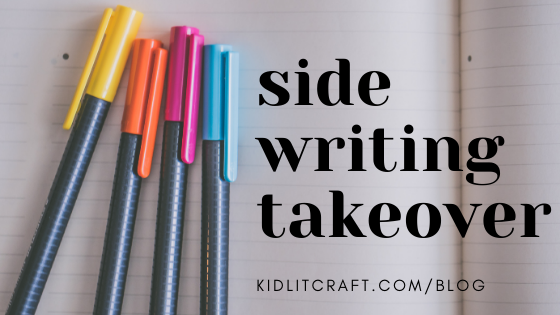interview by Anne-Marie Strohman
Sidewriting Takeover brings together writers of picture books, middle grade, and young adult fiction to explore how writing outside of a draft can help deepen your drafts and revisions. Each writer shares an exercise that they’ve found helpful. If you missed our initial post: START HERE.
I am lucky enough to be in a picture book critique group with Margaret. Her stories are thoughtful, funny, and super kid-friendly. Her critiquing superpower is being able to create a pitch for any story she reads, getting to the heart of what is working and not working in a story based on how that story can be summed up. I shouldn’t have been surprised to find out that Margaret writes pitches for her own stories as a part of her sidewriting. But I’ll let her tell you about it. –Anne-Marie
KidLit Craft: How has sidewriting become a part of your writing process? Were you always a sidewriter?
Margaret Chiu Greanias: Until I was asked to do this interview, I’d never heard of sidewriting. I thought maybe it was something only novelists did. But as I read Erin Nuttall’s kick-off post, I realized sidewriting is something picture book writers could do too. And then, I realized it was something that I actually do do.
Since I first began writing picture books, I have done sidewriting in some shape or form. Mostly, I’ve done it whenever I get stuck.
Through sidewriting, I’ve explored my story. I’ve fleshed out my characters. I’ve defined their worlds and how they work. All this helped me to know my story better so that I could reason out what might happen next.
In recent years, I’ve also started sidewriting before I even begin to draft my story (see below).
KLC: At what points in the process of writing a picture book do you sidewrite most?
MCG: I sidewrite at two points during my writing process:
- Prewriting: Rather than diving into writing as soon as I come up with a story concept, I use sidewriting to both generate ideas and organize/solidify them.
- I freewrite my thoughts on what I want the story to be. I explore theme and messaging first and then things like character, problem, even the ending idea.
- I’ll craft a pitch which acts like a mission statement. I use it to remind me what my story is about and to keep me focused as I’m writing. Otherwise, I might end up with a whole different story than the one I wanted to write!
- I explore how the story will play out. Sometimes I’ll do a story spine to make sure the story makes sense and escalates. Other times, it’s much looser—just jotting down possibilities for where the story could go.
Only when I’ve got a good chunk of this down will I actually draft the story.
- In middle: Whenever I get stuck, I sidewrite to learn more about the character, their situation, and their world. This generally helps me understand things better so that I can figure out a solution. Sometimes, sidewriting is synonymous with brainstorming, and I generate lots of solutions so I can pick and choose the best or most creative ones to unstick my story.
KLC: How does sidewriting help you?
MCG: Sidewriting helps me get my thoughts out and process them. It’s important for me to get my thoughts down on paper (or in some electronic form—I’ve been using draft emails lately). Otherwise, I’ll either forget about them or obsess about them so that I don’t forget about them. Neither is ideal!
Ultimately, sidewriting helps me get to know my story. When I know what I want my story to be about, it shortens my writing process:
- Drafting is easier—sometimes it’s stringing together bits of sidewriting. It’s still ugly, but it’s not that painful first draft.
- Revising is easier—I’m able to see where my story has veered off course and also better evaluate critique partner feedback.
SIDEWRITING CHALLENGE: PREWRITE
Try one or more of my prewriting activities: freewrite about what you hope the story will be, including theme, message, character, problem, and/or ending; craft a pitch to keep you focused; and explore plot with either a story spine or a looser list of what could happen in the story.
SIDEWRITING CHALLENGE: ASK “WHY?”

My favorite sidewriting exercise (and the simplest) is to continuously ask myself “why?” questions. I ask and write out answers until I have a better understanding of whatever character, problem, situation, etc. I’m struggling with. Give it a try!

Margaret Chiu Greanias is the author of picture books Maximillian Villainous and the upcoming Amah Faraway (Jan 2022). She currently lives in the San Francisco Bay Area with her husband, three children, and a fluffle of dust bunnies.
Find her online at margaretgreanias.com, Twitter: @MargaretGreania, IG: @MargaretGreanias, and her Facebook Author Page.
For more of our Sidewriting Takeover series, check out these posts:
Riffing on Your Influences and Auditioning Your Characters with Jasmine A. Stirling
Start with a Glimmer with Sarah Aronson
Write an “I Am From” Poem with Beth Mitchell
Create a Travel Brochure and Journal Your Process with Evan Griffith
Messy Sidewriting with Kristi Wright
Subscribe to our monthly newsletter: it’s full of writing tips, featured author content, and inspiration.
Anne-Marie Strohman (co-editor) writes picture books, middle grade novels, and young adult short stories and novels. She is trained as a teacher, an editor, and a scholar, specializing in Renaissance Literature. She holds an MFA in Writing for Children and Young Adults from Vermont College of Fine Arts and is an active member of SCBWI. Find her at amstrohman.com and on Twitter @amstrwriter.



COMMENTs:
0